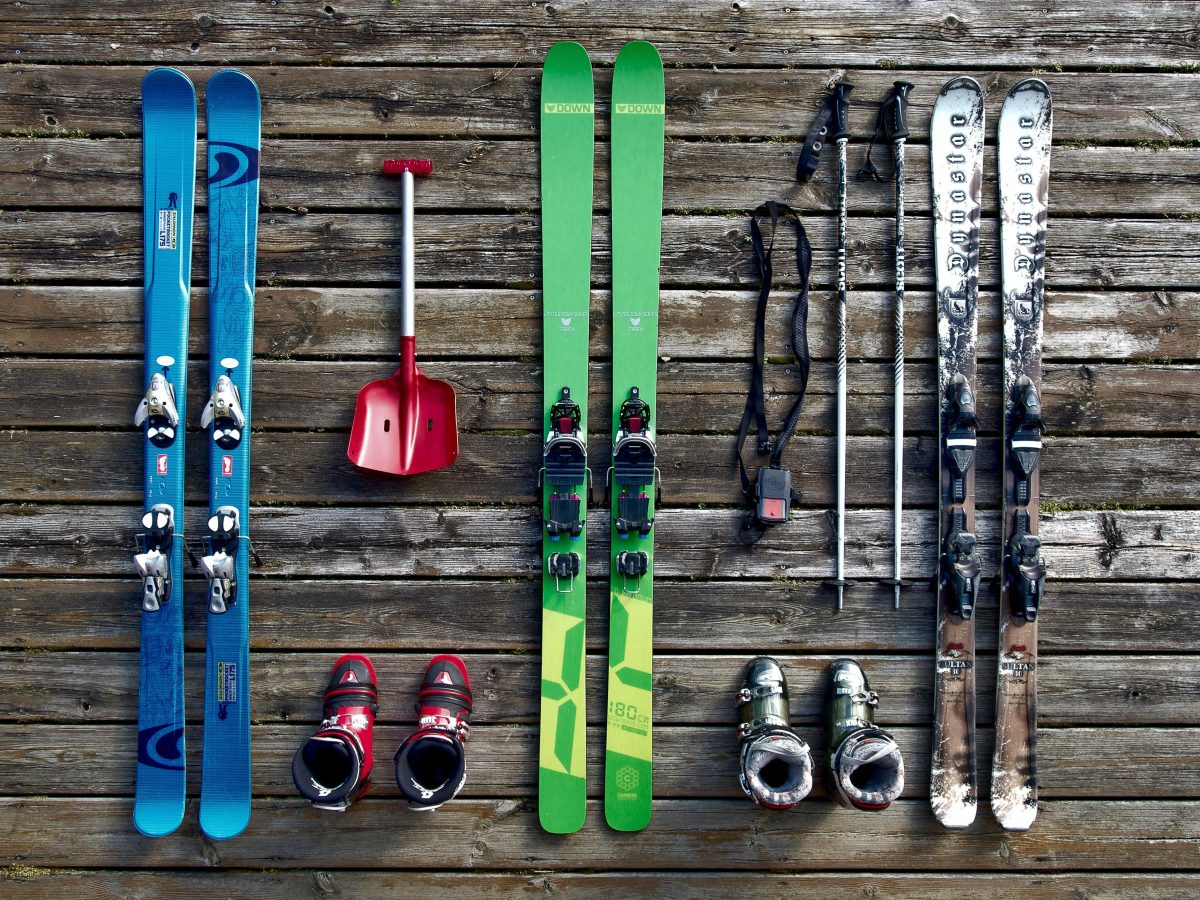Last Updated on: 14th July 2024, 09:28 am
Introduction to Winter Sports Gear

Embarking on winter sports adventures without the right gear is like stepping into a blizzard in shorts and flip-flops. It’s not just about comfort; it’s about safety and enhancing performance on the snow or ice. Proper gear acts as a shield against the elements and a catalyst for your prowess, whether you’re carving down slopes or gliding over frozen lakes.
- Skiers and snowboarders require insulated, waterproof clothing, helmets, and specific boots that latch onto their skis or boards.
- Cross-country skiers prioritize lightweight materials for better endurance and speed.
- Ice climbers need specialized boots with crampons and ice axes, designed for vertical ice surfaces.
- Snowshoers rely on their snowshoes to distribute weight and prevent sinking into deep snow, alongside poles for balance and navigation.
The right gear not only elevates your experience but also guards against the risks inherent in these exhilarating sports. It’s the difference between a memorable adventure and a cautionary tale. So, as you prepare to embrace the chill and thrill of winter sports, remember: the right gear is your best ally.
Layering Essentials for Warmth and Protection

Base Layers: The Foundation of Comfort
At the core of staying warm is the base layer, which directly touches your skin. The significance of moisture-wicking materials here cannot be overstated. By drawing sweat away from your body, these fabrics keep you dry, preventing the chill that comes from damp clothing against your skin. A dry body is a warm body, especially in the cold.
Insulating Layers: Trapping Heat Where It Counts
Next comes the insulating layer, your main defense against the biting cold. Options abound, from fleece and wool to modern synthetic materials designed to retain body heat. The goal is simple: trap warm air close to your body. This layer can be adjusted based on the temperature and your activity level, ensuring you stay warm but not overheated.
Outer Layers: The Shield Against Nature’s Fury
Finally, the outer layer protects against wind and water. When looking for jackets and pants, prioritize waterproof and windproof features. Sealed seams, durable water repellent (DWR) coatings, and breathable fabrics are key. They block out moisture and wind, preserving the warmth generated by your base and insulating layers. This protective shell is your final barrier, keeping you dry and shielded from the harsh elements.
Together, these layers form a dynamic system that can be adjusted to suit changing conditions, ensuring you stay warm, dry, and protected on your winter sports adventures. Remember, the right layering is not just about adding bulk; it’s about adding the right kind of protection, where and when you need it most.
Footwear: From Ski Boots to Snowboard Boots

Finding the Perfect Ski Boots
Finding the right ski boots is a game-changer for your performance and comfort on the slopes. A perfect fit ensures your movements are precisely translated to your skis, with flexibility tailored to your skiing style. Start with a professional fitting to determine your foot’s size and volume. Remember, the right boot has a snug fit without causing discomfort, allowing for slight toe movement. Flexibility varies; stiffer boots offer more control at high speeds, while softer ones provide comfort and are forgiving for beginners.
Snowboard Boots: Comfort Meets Convenience
When it comes to snowboarding, the right boots can make all the difference. Comfort is paramount, as you’ll spend long hours on the mountain. Look for boots with a quick lacing system; they not only ensure a secure fit but also allow for easy adjustments on the go. This feature is invaluable, letting you focus on your ride rather than fiddling with your boots.
The Unsung Heroes: Socks
Don’t underestimate the power of the right socks. Wool and synthetic blends reign supreme in the world of winter sports, offering the best of both worlds. They keep your feet warm and dry by wicking away moisture, a critical factor in maintaining comfort and preventing blisters. Opt for socks specifically designed for skiing or snowboarding, as they provide targeted cushioning and support where you need it most.
Together, the right footwear and socks form the foundation of your winter sports gear. They not only enhance your performance but also ensure you can enjoy the slopes all day long. Invest in quality, and your feet will thank you for it.
Head and Hand Protection: Safeguarding Your Extremities

Helmets: The First Line of Defense
When it comes to head protection, helmets are non-negotiable. They must meet rigorous safety standards to ensure they can absorb impacts effectively. A proper fit is crucial; a helmet should sit snugly on your head, with no room for it to wobble. Adjustable straps and padding allow for a custom fit, ensuring maximum protection and comfort. Remember, a well-fitted helmet can be the difference between a minor mishap and a serious injury.
Goggles: Clarity in the Midst of Snow
Goggles are your windows to the winter world. They must offer clear visibility, UV protection, and anti-fog features to keep your vision sharp in all conditions. Look for lenses that offer a wide field of view and are compatible with your helmet. UV protection is vital for safeguarding your eyes from harmful rays, while anti-fog technology ensures your lenses stay clear, allowing you to navigate the slopes safely.
Gloves vs. Mittens: A Handful of Warmth
The debate between gloves and mittens is a matter of preference, but both must provide warmth, durability, and dexterity. Gloves offer more dexterity, making them ideal for tasks requiring fine motor skills, while mittens keep your fingers together, often providing superior warmth. Look for materials that offer insulation and water resistance, ensuring your hands stay warm and dry. Features like wrist straps and touchscreen compatibility add convenience and functionality to your winter sports experience.
Protecting your head and hands is paramount in winter sports. By choosing the right helmets, goggles, gloves, or mittens, you ensure your safety while enhancing your performance. These essentials act as your armor against the elements, allowing you to focus on the thrill of the sport with peace of mind.
Technical Equipment for Skiing and Snowboarding

Skis and Snowboards: Tailoring to Your Adventure
Choosing the right skis or snowboard is pivotal, as it directly influences your control and enjoyment on the slopes. For beginners, softer, more flexible equipment offers forgiveness, making it easier to learn the basics. As skill levels advance, stiffer options provide the precision and responsiveness needed for aggressive, high-speed maneuvers. Terrain also dictates choice; powder skis and boards are wider for flotation, while park-specific designs focus on maneuverability for tricks and jumps.
Bindings: The Critical Link
Bindings are not just a connection point; they are a safety mechanism. They must precisely match your boot size and type, ensuring a secure fit. Look for bindings with easy release settings to prevent injuries during falls. Compatibility is key—ensure your bindings and boots are a match made in winter sports heaven.
Bindings also come with various features tailored to different skill levels and styles. Beginners benefit from more forgiving settings, allowing easier release, while advanced riders often prefer tighter settings for better control at high speeds.
Poles: More Than an Afterthought
Poles aid balance and propulsion, especially in technical terrains. Length is crucial; too short, and you’ll be hunching over; too long, and they’ll be cumbersome. A good rule of thumb is to flip the pole upside down and grab it below the basket—if your elbow forms a 90-degree angle, it’s the right size. Material-wise, aluminum offers durability and affordability, while carbon fiber is lighter and absorbs shock, catering to those who prioritize speed and performance.
Choosing the right technical equipment for skiing and snowboarding enhances not only your performance but also your safety on the slopes. With the right skis or snowboard, bindings, and poles tailored to your skill level and preferred terrain, you’re set for an exhilarating, secure winter sports experience.
Accessories That Make a Difference

Backpacks: Equipped for the Unexpected
- Hydration Systems: Backpacks with built-in hydration systems allow athletes to drink on the go, keeping the momentum uninterrupted.
- Avalanche Safety Tools: For backcountry adventurers, having probes and shovels can be life-saving, making these backpacks essential for emergency preparedness.
Sunscreen and Lip Balm: Your Invisible Armor
- Sunscreen: A high SPF sunscreen is vital for protecting your skin from sunburn and long-term UV damage.
- Lip Balm: Shield your lips against the biting cold and dry conditions with a nourishing lip balm.
Action Cameras and Mounts: Relive the Rush
- Versatile Mounts: Attach your action camera to a helmet, chest, or ski pole to capture every moment of your winter sports adventure.
- Extreme Durability: Designed to withstand harsh conditions, ensuring your memories are preserved no matter the weather.
In Closing
Gear up, adventure awaits. This journey is not just about facing the cold; it’s about embracing it. With the right gear, each winter sport becomes a doorway to unparalleled joy and exhilaration. From the essential layers that keep you warm to the technical equipment that enhances performance, every piece plays a crucial role in your winter sports narrative. Let’s step into the snow with confidence and a spirit of adventure, ready to make every moment on the slopes or ice unforgettable.
Essential Gear for Winter Sports FAQs
Sunglasses specifically designed for winter sports offer UV protection, wrap-around designs to block wind, and anti-fog features. Regular sunglasses may not provide adequate protection against glare from the snow or fit securely during active movement. Polarized lenses are a good option for reducing glare and improving visibility.
Yes, gloves designed for skiing or snowboarding offer waterproofing, insulation, and features like wrist guards or reinforced palms for grip and protection. They keep your hands warm and dry while providing the dexterity needed to handle equipment. Look for gloves with adjustable cuffs to fit over or under your jacket sleeves for added snow protection.
Boots should be chosen based on the specific activity, offering the right balance of warmth, waterproofing, and support. They should fit snugly while allowing for toe movement and be compatible with your bindings if applicable. Proper insulation, such as Thinsulate, and a moisture-wicking lining are key features to look for.
Goggles are essential for protecting your eyes from UV rays, wind, and snow. They also enhance visibility by reducing glare and increasing contrast, which is crucial for safety on the slopes. Make sure they fit well with your helmet and offer enough ventilation to prevent fogging.
Wearing a helmet is crucial for safety in all winter sports, as it significantly reduces the risk of head injuries. Helmets designed for winter sports are insulated for warmth and have vents for breathability. Ensure it fits properly and is certified for the sport you’re participating in.
A winter sports jacket should be waterproof, breathable, and have a windproof exterior, with features like sealed seams, a snow skirt, and adjustable cuffs. It should also offer sufficient insulation while allowing for layering underneath. Pockets for lift passes, goggles, and other essentials are also useful.
A snow skirt prevents snow from entering your jacket during falls or when skiing or snowboarding through deep powder. It adds an extra layer of protection against the cold and keeps you dry. Snow skirts are typically elasticated and can be fastened to create a seal around your waist or hips.
Layering is key for winter sports, starting with a moisture-wicking base layer, an insulating middle layer, and a waterproof outer layer. This combination keeps you dry, warm, and protected from the elements. Different activities might require adjustments in layer thickness or material, but the three-layer principle remains a constant.
Socks specifically designed for skiing and snowboarding, made from materials like merino wool, provide warmth, moisture-wicking, and cushioning in critical areas. They are typically knee-high to protect against boot rub and have few seams to prevent blisters. Avoid cotton as it retains moisture, leading to cold feet.
A high-quality base layer wicks moisture away from your skin, keeping you dry and warm. Materials like merino wool or synthetic fabrics are best as they maintain insulation even when wet and dry quickly. This layer is crucial for comfort and temperature regulation during physical activity.
Orlando is a all round athlete from Australia, now resident in Germany. His sports of passion of American Football(Offensive line), weight training and indoor rock climbing where he uses his 195cm wing span to his advantage.



